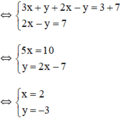1+4+7+....+(3x+1)=330
Tìm x là số tự nhiên
Hãy nhập câu hỏi của bạn vào đây, nếu là tài khoản VIP, bạn sẽ được ưu tiên trả lời.


a: \(x^3+8x=5x^2+4\)
=>\(x^3-5x^2+8x-4=0\)
=>\(x^3-x^2-4x^2+4x+4x-4=0\)
=>\(x^2\left(x-1\right)-4x\left(x-1\right)+4\left(x-1\right)=0\)
=>\(\left(x-1\right)\left(x^2-4x+4\right)=0\)
=>\(\left(x-1\right)\left(x-2\right)^2=0\)
=>\(\left[{}\begin{matrix}x-1=0\\\left(x-2\right)^2=0\end{matrix}\right.\Leftrightarrow\left[{}\begin{matrix}x=1\\x=2\end{matrix}\right.\)
2: \(x^3+3x^2=x+6\)
=>\(x^3+3x^2-x-6=0\)
=>\(x^3+2x^2+x^2+2x-3x-6=0\)
=>\(x^2\cdot\left(x+2\right)+x\left(x+2\right)-3\left(x+2\right)=0\)
=>\(\left(x+2\right)\left(x^2+x-3\right)=0\)
=>\(\left[{}\begin{matrix}x+2=0\\x^2+x-3=0\end{matrix}\right.\Leftrightarrow\left[{}\begin{matrix}x=-2\\x=\dfrac{-1+\sqrt{13}}{2}\\x=\dfrac{-1-\sqrt{13}}{2}\end{matrix}\right.\)
3: ĐKXĐ: x>=0
\(2x+3\sqrt{x}=1\)
=>\(2x+3\sqrt{x}-1=0\)
=>\(x+\dfrac{3}{2}\sqrt{x}-\dfrac{1}{2}=0\)
=>\(\left(\sqrt{x}\right)^2+2\cdot\sqrt{x}\cdot\dfrac{3}{4}+\dfrac{9}{16}-\dfrac{17}{16}=0\)
=>\(\left(\sqrt{x}+\dfrac{3}{4}\right)^2=\dfrac{17}{16}\)
=>\(\left[{}\begin{matrix}\sqrt{x}+\dfrac{3}{4}=-\dfrac{\sqrt{17}}{4}\\\sqrt{x}+\dfrac{3}{4}=\dfrac{\sqrt{17}}{4}\end{matrix}\right.\Leftrightarrow\left[{}\begin{matrix}\sqrt{x}=\dfrac{\sqrt{17}-3}{4}\left(nhận\right)\\\sqrt{x}=\dfrac{-\sqrt{17}-3}{4}\left(loại\right)\end{matrix}\right.\)
=>\(x=\dfrac{13-3\sqrt{17}}{8}\left(nhận\right)\)
4: \(x^4+4x^2+1=3x^3+3x\)
=>\(x^4-3x^3+4x^2-3x+1=0\)
=>\(x^4-x^3-2x^3+2x^2+2x^2-2x-x+1=0\)
=>\(x^3\left(x-1\right)-2x^2\left(x-1\right)+2x\left(x-1\right)-\left(x-1\right)=0\)
=>\(\left(x-1\right)\left(x^3-2x^2+2x-1\right)=0\)
=>\(\left(x-1\right)\left(x^3-x^2-x^2+x+x-1\right)=0\)
=>\(\left(x-1\right)^2\cdot\left(x^2-x+1\right)=0\)
=>(x-1)^2=0
=>x-1=0
=>x=1
a.
\(x^3+8x=5x^2+4\)
\(\Leftrightarrow x^3-5x^2+8x-4=0\)
\(\Leftrightarrow\left(x^3-4x^2+4x\right)-\left(x^2-4x+4\right)=0\)
\(\Leftrightarrow x\left(x-2\right)^2-\left(x-2\right)^2=0\)
\(\Leftrightarrow\left(x-1\right)\left(x-2\right)^2=0\)
\(\Rightarrow\left[{}\begin{matrix}x=1\\x=2\end{matrix}\right.\)
b.
\(x^3+3x^2-x-6=0\)
\(\Leftrightarrow\left(x^3+x^2-3x\right)+\left(2x^2+2x-6\right)=0\)
\(\Leftrightarrow x\left(x^2+x-3\right)+2\left(x^2+x-3\right)=0\)
\(\Leftrightarrow\left(x+2\right)\left(x^2+x-3\right)=0\)
\(\Rightarrow\left[{}\begin{matrix}x=-2\\x=\dfrac{-1\pm\sqrt{13}}{2}\end{matrix}\right.\)

#include <bits/stdc++.h>
using namespace std;
long long a,b;
char st;
int main()
{
cin>>a>>b;
cout<<"Nhap phep tinh:"; cin>>st;
if (st=='+') cout<<a+b;
if (st=='-') cout<<a-b;
if (st=='*') cout<<a*b;
if (st=='/') cout<<a/b;
return 0;
}

Giải:
Nhân cả 2 vế của phương trình với \(2.3.4\) ta được:
\(\left(12x-1\right)\left(12x-2\right)\left(12x-3\right)\left(12x-4\right)=330.2.3.4\)
\(\Rightarrow\left(12x-1\right)\left(12x-2\right)\left(12x-3\right)\left(12x-4\right)=11.10.9.8\)
\(VT\) là 4 số nguyên liên tiếp khác 0 nên các thừa số phải cùng dấu \(\left(+\right)\) hoặc \(\left(-\right)\)
Suy ra: \(\left(12x-1\right)\left(12x-2\right)\left(12x-3\right)\left(12x-4\right)=11.10.9.8\left(1\right)\)
Và \(\left(12x-1\right)\left(12x-2\right)\left(12x-3\right)\left(12x-4\right)=11.\left(-10\right).\left(-9\right).\left(-8\right)\left(2\right)\)
Từ \(PT\left(1\right)\Leftrightarrow12x-1=11\Leftrightarrow x=1\left(TM\right)\)
Từ \(PT\left(2\right)\Leftrightarrow12x-1=-8\Leftrightarrow x=\frac{-7}{12}\left(L\right)\)
Vậy \(x=1\) thỏa mãn phương trình

\(1,3x+2y=7\\ \Leftrightarrow2y=7-3x\left(1\right)\)
Vì \(2y⋮2\)
\(\Leftrightarrow3x-7⋮2\\ \Leftrightarrow3x-9⋮2\\ \Leftrightarrow3\left(x-3\right)⋮2\\ \Leftrightarrow x-3⋮2\\ \Leftrightarrow x.lẻ\)
Đặt \(x=2k+1\left(k\in Z\right)\)
Thay vào (1), ta được :
\(\left(1\right)\Leftrightarrow2y=3\left(2k+1\right)-7\\ \Leftrightarrow2y=6k+3-7\\ \Leftrightarrow2y=6k-4\\ \Leftrightarrow y=3k-2\)
Vậy \(x=2k+1;y=3k-2\left(k\in Z\right)\)
\(2,C_1:\left\{{}\begin{matrix}-2x+y=1\\4x+5y=3\end{matrix}\right.\Leftrightarrow\left\{{}\begin{matrix}-4x+2y=2\\4x+5y=3\end{matrix}\right.\\ \Leftrightarrow\left\{{}\begin{matrix}4x+5y=2\\7y=5\end{matrix}\right.\Leftrightarrow\left\{{}\begin{matrix}x=-\dfrac{1}{7}\\y=\dfrac{5}{7}\end{matrix}\right.\\ C_2:\left\{{}\begin{matrix}-2x+y=1\\4x+5y=3\end{matrix}\right.\Leftrightarrow\left\{{}\begin{matrix}y=1+2x\\4x+5y=3\end{matrix}\right.\Leftrightarrow4x+5+10x=3\\ \Leftrightarrow x=-\dfrac{1}{7}\Leftrightarrow y=1-\dfrac{2}{7}=\dfrac{5}{7}\)

(Các phần giải thích học sinh không phải trình bày).
 (Vì hệ số của y ở 2 pt đối nhau nên cộng từng vế của 2 pt).
(Vì hệ số của y ở 2 pt đối nhau nên cộng từng vế của 2 pt).

Vậy hệ phương trình có nghiệm duy nhất (2; -3).
Tìm số tự nhiên x sao cho tổng 1+4+7+...+(3x+1) bằng 330.
Dùng công thức cũ:
(3x^2 + 2x)/2 = 330
Nhân hai vế bằng 2:
3x^2 + 2x = 660
Trừ 660 khỏi hai vế:
3x^2 + 2x - 660 = 0
Biết nhân tử:
(3x + 30)(x - 22) = 0
Được hai giá trị của x:
3x + 30 = 0 --> x = -10 (hóa, vì x là số tự nhiên)
x - 22 = 0 --> x = 22 (hóa, vì x không phải là số tự nhiên)
Tuy nhiên, chúng ta có thể tìm một giá trị gần đúng của x sao cho tổng gần bằng 330. Dùng công thức viết lại:
x ≈ (-b ± √(b^2 - 4ac)) / (2a)
Trong trường hợp này, a = 3, b = 2, và c = -660. Đưa vào những giá trị này, chúng ta có:
x ≈ (-2 ± √(4 - 4(3)(-660))) / (2(3)) ≈ (-2 ± √(2464)) / (6) ≈ (-2 ± √49.28) / (6) ≈ (-2 ± 7.02) / (6)
Vậy chúng ta có hai giá trị gần đúng của x:
x ≈ (-2 + 7.02) / (6) ≈ 1.17 x ≈ (-2 - 7.02) / (6) ≈ -1.83
Vì x phải là số tự nhiên, chúng ta có thể tròn giá trị đầu tiên xuống gần nhất, tức là x ≈ 1.
Tóm lại, giá trị gần đúng của x là x ≈ 1.